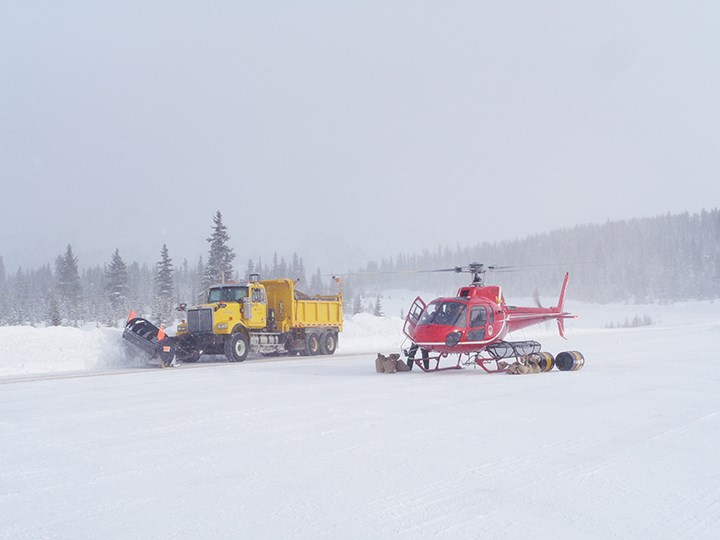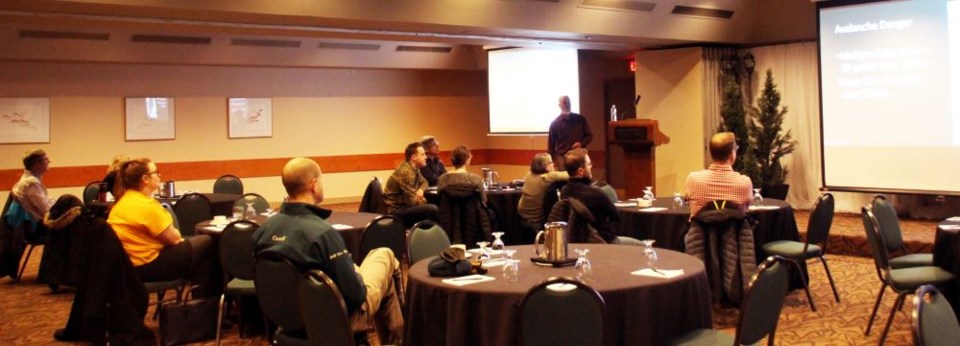
Joanne McQuarrie, Local Journalism Initiative Reporter | [email protected]
Avalanches are part of life in the mountains, and a Parks Canada team monitors conditions daily to be as prepared as possible when road closures are issued.
Rupert Wedgwood, visitor safety supervisor with Parks Canada and avalanche expert, shared the science behind road closures at a meeting hosted by the Jasper Park Chamber of Commerce (JPCC) at the Sawridge Inn and Conference Centre on Feb. 11.
The session came shortly after a special public avalanche warning was issued for Jasper and areas of British Columbia last week.
Wedgwood said avalanche risk is greater between November and May, but they can occur year-round.
In determining the risk of an avalanche, three elements are considered: the terrain, the instability of the snowpack and a trigger.
There are two main kinds of avalanches: loose snow avalanches and slab avalanches.
“Loose snow avalanches are less destructive than slabs,” Wedgwood said.
“They’re typically slower moving and they’re common during warm periods. They’re quite dense because of moist snow, they’re slow-moving, they’re quite predictable.”
Loose snow avalanches move at about 30 kilometres per hour, but while that may seem unthreatening to some people, Wedgwood warned that this speed was enough to seriously hurt people.
Slab avalanches, meanwhile, are much riskier.
“They’re more destructive, they persist as a problem, they’re more frequent and faster moving,” Wedgwood said.
“Snow is released in big slabs from the crown. Slab avalanches are very common throughout the winter and typically our main problem.”
There are four sizes of avalanches.
Size 1 is relatively harmless and tends to occur in 10-metre distances.
Size 2 avalanches are in lengths of 100 metres, with Wedgwood saying these were big enough to kill a person and that most avalanche fatalities happen in a size 2 avalanche.
Size 3 avalanches can bury or destroy a car, damage a truck, destroy a wood frame house, or break a few trees.
“There’s thousands of tons of debris (with these),” Wedgwood said.
A size 4 avalanche can destroy a rail car or large truck, destroy four hectares and are 2,000 m in length.
Wedgwood said size 4 avalanches may happen once in 100 or 200 years.
“It can be very difficult to anticipate when they’ll release,” he said.

These elements are considered in avalanche risks: highway avalanche danger, motorists, tour buses, highway maintenance, EMS, tow trucks, construction crews, cyclists and pedestrians.
The daily risk assessment includes weather forecast, snowpack structure, monitoring the weather, reviewing the nearest neighbours, confirming with field observation, determining the risk and setting objectives in consultation with highways.
It also involves establishing a plan, which involves organization, communication, tactical, monitoring and reviewing, updating and executing the plan.
With weather forecasts, elements considered include snowfall/rain, air temperature, freezing level, relative humidity, solar radiation and dew point.
In strategizing a plan of action, information is prioritized, and it’s determined if it’s a maintenance run or risk reduction and what weather and lighting will allow, and what resources are available, and handoff to highways.
A meeting attendee asked about notifications to the public, in the context of how road closures affect tourists’ plans.
“When we have natural events, we’re putting staff out as quickly as we can,” said Neil McInnis, external relations manager with the Jasper Field Unit.
“Public safety is always job one.”
Alan Fehr, superintendent, Jasper Field Unit, added that with avalanches, “there’s a lot of unpredictability. We’re dealing with a natural process, there’s so many variables. (We) give people as much of a heads-up as we can give them.”
JPCC executive director Pattie Pavlov reiterated that avalanches are a natural process.
“We live in a geographical space where stuff like this is going to happen,” she said. “The more people know and can notify their frontline staff, the more they can plan ahead.”
“There are so many things done on a daily basis, sometimes twice a day,” Pavlov added. “When mother nature decides to throw in a curve ball, that’s the way it is. You may have delays because of nature.”
The Icefields Parkway was closed on Feb. 10 just for the day.
Kevin Gedling, acting public relations and communications officer, said Parks Canada planned for rolling avalanche control, but there was a natural slide which triggered full closure of the parkway from Saskatchewan Crossing to Jasper.
Motorists are advised to check before setting off.



